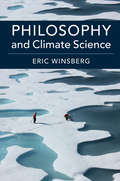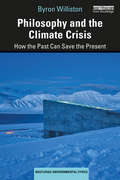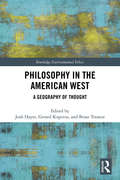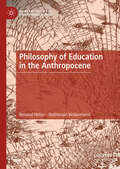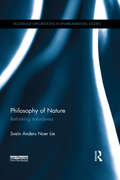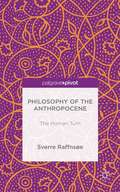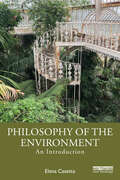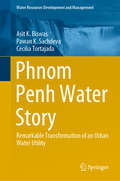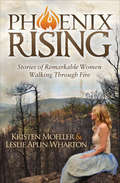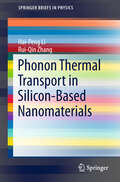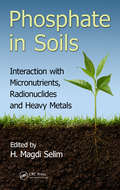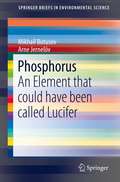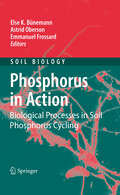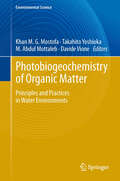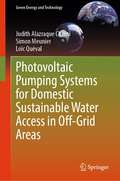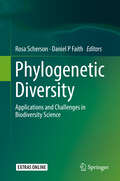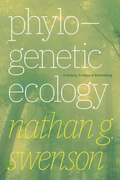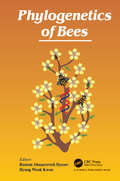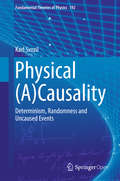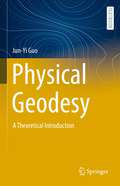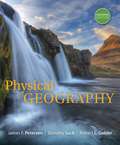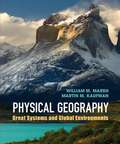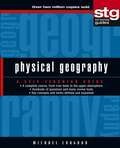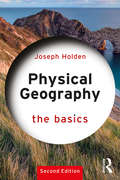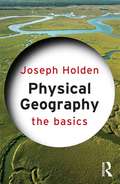- Table View
- List View
Philosophy and Climate Science
by Eric WinsbergThere continues to be a vigorous public debate in our society about the status of climate science. Much of the skepticism voiced in this debate suffers from a lack of understanding of how the science works - in particular the complex interdisciplinary scientific modeling activities such as those which are at the heart of climate science. <P><P>In this book Eric Winsberg shows clearly and accessibly how philosophy of science can contribute to our understanding of climate science, and how it can also shape climate policy debates and provide a starting point for research.<P>Covering a wide range of topics including the nature of scientific data, modeling, and simulation, his book provides a detailed guide for those willing to look beyond ideological proclamations, and enriches our understanding of how climate science relates to important concepts such as chaos, unpredictability, and the extent of what we know.<P> Provides a comprehensive and accessible introduction to the philosophy of climate science.<P> Advances our understanding of how philosophy can contribute to debates in climate science.<P> Offers useful case studies and suggestions for further reading.
Philosophy and the Climate Crisis: How the Past Can Save the Present (Routledge Environmental Ethics)
by Byron WillistonThis book explores how the history of philosophy can orient us to the new reality brought on by the climate crisis. If we understand the climate crisis as a deeply existential one, it can help to examine the way past philosophers responded to similar crises in their times. This book explores five past crises, each involving a unique form of collective trauma. These events—war, occupation, exile, scientific revolution and political revolution—inspired the philosophers to remake the whole world in thought, to construct a metaphysics. Williston distills a key intellectual innovation from each metaphysical system: • That political power must be constrained by knowledge of the climate system (Plato) • That ethical and political reasoning must be informed by care or love of the ecological whole (Augustine) • That we must enhance the design of the technosphere (Descartes) • That we must conceive the Earth as an internally complex system (Spinoza) • And that we must grant rights to anyone or anything—ultimately the Earth system itself—whose vital interests are threatened by the effects of climate change (Hegel). Philosophy and the Climate Crisis will be of great interest to students and scholars of climate change, environmental philosophy and ethics and the environmental humanities.
Philosophy in the American West: A Geography of Thought (Routledge Environmental Ethics)
by Josh Hayes Brian Treanor Gerard KuperusPhilosophy in the American West explores the physical, ecological, cultural, and narrative environments associated with the western United States, reflecting on the relationship between people and the places that sustain them. The American West has long been recognized as having significance. From Crèvecoeur’s early observations in Letters from an American Farmer (1782), to Thoreau’s reflections in Walden (1854), to twentieth-century thoughts on the legacy of a vanishing frontier, "the West" has played a pivotal role in the American narrative and in the American sense of self. But while the nature of "westernness" has been touched on by historians, sociologists, and, especially, novelists and poets, this collection represents the first attempt to think philosophically about the nature of "the West" and its influence on us. The contributors take up thinkers that have been associated with Continental Philosophy and pair them with writers, poets, and artists of "the West". And while this collection seeks to loosen the cords that tie philosophy to Europe, the traditions of "continental" philosophy—phenomenology, hermeneutics, deconstruction, and others—offer deep resources for thinking through the particularity of place. This book will be of great interest to students and scholars of Philosophy, as well as those working in Ecocriticism and the Environmental Humanities more broadly.
Philosophy of Education in the Anthropocene (Palgrave Studies in Educational Futures)
by Renaud Hétier Nathanaël WallenhorstThis book develops a philosophy of education for the Anthropocene, proposing that we think about education in the light of contemporary bioclimatic challenges. Education is seen as the political means of choice for containing the runaway Earth system change and ensuring the sustainability of human life in society. In this book, Hétier and Wallenhorst continue their work on the biogeophysical and socio-political analysis of the Anthropocene here, tracing the path toward the re-founding of a political education to prepare students to address the greatest challenge of our time: the gradual disappearance of the bioclimatic conditions necessary for our very existence.
Philosophy of Nature: Rethinking naturalness (Routledge Explorations in Environmental Studies)
by Svein Anders LieThe concept of naturalness has largely disappeared from the academic discourse in general but also the particular field of environmental studies. This book is about naturalness in general – about why the idea of naturalness has been abandoned in modern academic discourse, why it is important to explicitly re-establish some meaning for the concept and what that meaning ought to be. Arguing that naturalness can and should be understood in light of a dispositional ontology, the book offers a point of view where the gap between instrumental and ethical perspectives can be bridged. Reaching a new foundation for the concept of ‘naturalness’ and its viability will help raise and inform further discussions within environmental philosophy and issues occurring in the crossroads between science, technology and society. This topical book will be of great interest to researchers and students in Environmental Studies, Environmental Philosophy, Science and Technology Studies, Conservation Studies as well as all those generally engaged in debates about the place of ‘man in nature’.
Philosophy of the Environment: An Introduction
by Elena CasettaThis textbook offers a reasoned and accessible introduction to the philosophy of the environment and the current environmental crisis, designed for scholars and students in both philosophy and the natural and environmental sciences.The volume addresses the history and meanings of the concept of "environment", provides a theory of the relation between living beings and their environments, and tackles a wide spectrum of key philosophical issues related to the environment and the environmental crisis in a straightforward framework and accessible style. The book’s unique approach to environmental philosophy addresses the environment of all living beings and extends beyond environmental ethics to include conceptual history and analysis together with insights from evolutionary and developmental biology, ecology, and environmental and conservation sciences. The book consists of five chapters, each built around a specific thesis drawing upon philosophers and concepts including George Canguilhem, Rachel Carson, Donna Haraway, Lamarck’s and Darwin's evolutionary theories, Humboldt’s theory of nature, and the Gaia hypothesis. The final chapter introduces topics such as environmental denialism and post-natural environmentalism as conceptual tools for better understanding the current ecological crisis.Targeted at students and scholars in both philosophy and the environmental and life sciences, the book distinguishes itself through its approachable style and choice of topics, which are also well suited to junior researchers who seek to better understand the current environmental crisis.
Phnom Penh Water Story: Remarkable Transformation of an Urban Water Utility (Water Resources Development and Management)
by Asit K. Biswas Cecilia Tortajada Pawan K. SachdevaThis book analyses how a water utility from a developing country, Phnom Penh Water Supply Authority, that was totally dysfunctional, corruption-ridden and literally bankrupt in 1993, became one of the most successful water utilities of the developing world in only about 15 years. By 2010, some of the performance indicators of this public sector utility were even better than London, Paris or Los Angeles. The book further analyses the enabling conditions that made this remarkable transformation possible. Based on this analysis, a framework is recommended for water utilities from developing countries so that they can also be transformed into functional, efficient, equitable and financially viable institutions on a sustainable basis.
Phoenix Rising: Stories of Remarkable Women Walking Through Fire
by Kristen Moeller Leslie Alpin WhartonHow do you go on after you&’ve lost everything? True stories of surviving the Colorado wildfires and finding hope for the future. Over several terrifying summers, deadly wildfires raged across Colorado. Lives were lost, and the flames destroyed thousands of homes. When the smoke cleared and only rubble remained, survivors were left trying to find a way forward against devastating loss. The aftermath of that destruction would span many years, and its effects are still felt today. In Phoenix Rising, twenty women share their stories of fire, the terror they felt as flames engulfed their communities, and the dark desperation that followed. And how—in the ensuing weeks and months—they worked to recreate a life from the ashes. Their tales of fear and bravery, of deep compassion and heart-rending grief, offer an uplifting chronicle of human courage and resilience. &“[A] gem of a book . . . When it comes to withstanding and making meaning of the most painful twists of this mysterious life, or enjoying its surprising rewards, nothing compares to the company of other women and their stories.&” —Megan Feldman Bettencourt, author of Triumph of the Heart: Forgiveness in an Unforgiving World
Phonon Thermal Transport in Silicon-Based Nanomaterials (SpringerBriefs in Physics)
by Rui-Qin Zhang Hai-Peng LiIn this Brief, authors introduce the advance in theoretical and experimental techniques for determining the thermal conductivity in nanomaterials, and focus on review of their recent theoretical studies on the thermal properties of silicon–based nanomaterials, such as zero–dimensional silicon nanoclusters, one–dimensional silicon nanowires, and graphenelike two–dimensional silicene. The specific subject matters covered include: size effect of thermal stability and phonon thermal transport in spherical silicon nanoclusters, surface effects of phonon thermal transport in silicon nanowires, and defects effects of phonon thermal transport in silicene. The results obtained are supplemented by numerical calculations, presented as tables and figures. The potential applications of these findings in nanoelectrics and thermoelectric energy conversion are also discussed. In this regard, this Brief represents an authoritative, systematic, and detailed description of the current status of phonon thermal transport in silicon–based nanomaterials. This Brief should be a highly valuable reference for young scientists and postgraduate students active in the fields of nanoscale thermal transport and silicon-based nanomaterials.
Phosphate in Soils: Interaction with Micronutrients, Radionuclides and Heavy Metals (Emergent Environmental Pollution)
by H. Magdi SelimEdited by One of the Best Specialists in Soil ScienceRecent studies reveal that Phosphorus (P) in the form of phosphate, a macronutrient essential for plant growth, and crop yields can influence the bioavailability, retention, and mobility of trace elements, metal(loid)s, and radio nuclides in soils. When this occurs, phosphates can affect the dynamics of heavy metals and influence soil characteristics, impacting soil mobility and toxicity. Phosphate in Soils: Interaction with Micronutrients, Radionuclides and Heavy Metals utilizes the latest research to emphasize the role that phosphate plays in enhancing or reducing the mobility of heavy metals in soil, and the soil-water-plant environment. It provides an in-depth understanding of each heavy metal species, and expands on phosphate interactions in geological material.Composed of 12 chapters, this text: Provides an overview of the reactions of metal(loid)s and common P compounds that are used as fertilizer in soils Emphasizes the effect of phosphorus on copper and zinc adsorption in acid soils Discusses findings on the influence of phosphate compounds on speciation, mobility, and bioavailability of heavy metals in soils as well as the role of phosphates on in situ and phytoremediation of heavy metals for contaminated soils Places emphasis on the influence of phosphate on various heavy metals species in soils, and their solubility/mobility and availability Provides extensive information on testing various high phosphate materials for remediation of heavy metal, micronutrients, and radionuclides contaminated sites Explores the reactivity of heavy metals, micronutrients and radionuclides elements in several soils Presents a case study illustrating various remediation efforts of acidic soils and remediation of Cu, Zn, and lead (Pb) contaminated soils around nonferrous industrial plants Emphasizes the significance of common ions (cations and anions) on phosphate mobility and sorption in soils, and more The author includes analytical and numerical solutions along with hands-on applications, and addresses other topics that include the transport and sorption modeling of heavy metals in the presence of phosphate at different scales in the vadose zone.
Phosphorus
by Arne Jernelöv Mikhail ButusovThis book starts with depiction of the phosphorus role in life creation and evolution. Then it outlines in which vital processes different phosphates participate in life of all flora and fauna, from DNA molecules till body tissues. Crucial function of phosphates was noticed long ago, but only in XIX century discovery of mineral fertilizers made it possible to sustain the needs of growing global population, thus initiating a "green revolution". Though, for many decades after it, the complexity of interactions "fertilizer-soil-plant roots" was underrated, causing massive damages, such as soil destruction and eutrophication of waters. Still, mining of exhausting natural phosphate reserves continued worldwide. Lessons of what happened in XIX century due to scarcity of phosphates were ignored. In the meantime, production of phosphates reached its peak few years ago. Immediate implementation of phosphate recycling technologies from municipal wastes can help avoid imminent global disaster.
Phosphorus in Action
by Astrid Oberson Else K. Bünemann Emmanuel FrossardPhosphorus (P) is a finite resource which is essential for life. It is a limiting nutrient in many ecosystems but also a pollutant which can affect biodiversity in terrestrial ecosystems and change the ecology of water bodies. This book collects the latest information on biological processes in soil P cycling, which to date have remained much less understood than physico-chemical processes. The methods section presents spectroscopic techniques and the characterization of microbial P forms, as well as the use of tracers, molecular approaches and modeling of soil-plant systems. The section on processes deals with mycorrhizal symbioses, microbial P solubilization, soil macrofauna, phosphatase enzymes and rhizosphere processes. On the system level, P cycling is examined for grasslands, arctic and alpine soils, forest plantations, tropical forests, and dryland regions. Further, P management with respect to animal production and cropping, and the interactions between global change and P cycling, are treated.
Photobiogeochemistry of Organic Matter
by Davide Vione Khan M.G. Mostofa Takahito Yoshioka Abdul MottalebPhotoinduced processes, caused by natural sunlight, are key functions for sustaining all living organisms through production and transformation of organic matter (OM) in the biosphere. Production of hydrogen peroxide (H2O2) from OM is a primary step of photoinduced processes, because H2O2 acts as strong reductant and oxidant. It is potentially important in many aquatic reactions, also in association with photosynthesis. Allochthonous and autochthonous dissolved organic matter (DOM) can be involved into several photoinduced or biological processes. DOM subsequently undergoes several physical, chemical, photoinduced and biological processes, which can be affected by global warming. This book is uniquely structured to overview some vital issues, such as: DOM; H2O2 and ROOH; HO*; Degradation of DOM; CDOM, FDOM; Photosynthesis; Chlorophyll; Metal complexation, and Global warming, as well as their mutual interrelationships, based on updated scientific results.
Photovoltaic Pumping Systems for Domestic Sustainable Water Access in Off-Grid Areas (Green Energy and Technology)
by Judith Alazraque Cherni Simon Meunier Loïc QuévalThis book offers practical guidance for practitioner engineers, policymakers, and other decision-makers on how to implement solar photovoltaic water pumping systems to provide domestic clean water in off-grid regions of developing countries. By championing genuine multidisciplinary research and generating interdisciplinary results, this book develops models and approaches which indicate how it might be possible to overcome some of the limitations that technocratic approaches to renewable energy and water access pose to truly sustainable development.The book addresses technical challenges often found when promoting photovoltaic water pumping systems. It offers practical guidance to stakeholders on how to successfully select, install, and maintain photovoltaic water pumps to promote sustainable options for the poorest underserved areas/populations. A main novelty of this book is that, by using theoretical, as well as real/actual field-work data, and advanced modelling, it successfully connects energy systems engineering, environmental and geographical information and hydrology with population surveys which reveal local needs and conditions.The book is timely and important. More than 665 700 million worldwide still do not have access to improved drinking water sources; eight out of ten live in rural areas typically located either in off-grid territory, or where connection to nearby grid is too expensive or unfeasible. Unsafe water is responsible for 1.2 million deaths each year, mainly correlated with the diarrheal diseases generated from drinking water from unimproved water sources. Sustainable Development Goal 6 (clean water and sanitation) may be achieved only if water is accessible to everyone, available when needed and free from contamination.
Phylogenetic Diversity: Applications and Challenges in Biodiversity Science
by Rosa A. Scherson Daniel P Faith“Biodiversity” refers to the variety of life. It is now agreed that there is a “biodiversity crisis”, corresponding to extinction rates of species that may be 1000 times what is thought to be “normal”. Biodiversity science has a higher profile than ever, with the new Intergovernmental Science-Policy Platform on Biodiversity and Ecosystem Services involving more than 120 countries and 1000s of scientists. At the same time, the discipline is re-evaluating its foundations – including its philosophy and even core definitions. The value of biodiversity is being debated. In this context, the tree of life (“phylogeny”) is emerging as an important way to look at biodiversity, with relevance cutting across current areas of concern – from the question of resilience within ecosystems, to conservation priorities for globally threatened species – while capturing the values of biodiversity that have been hard to quantify, including resilience and maintaining options for future generations.This increased appreciation of the importance of conserving “phylogenetic diversity”, from microbial communities in the human gut to global threatened species, has inevitably resulted in an explosion of new indices, methods, and case studies. This book recognizes and responds to the timely opportunity for synthesis and sharing experiences in practical applications. The book recognizes that the challenge of finding a synthesis, and building shared concepts and a shared toolbox, requires both an appreciation of the past and a look into the future. Thus, the book is organized as a flow from history, concepts and philosophy, through to methods and tools, and followed by selected case studies. A positive vision and plan of action emerges from these chapters, that includes coping with inevitable uncertainties, effectively communicating the importance of this “evolutionary heritage” to the public and to policy-makers, and ultimately contributing to biodiversity conservation policy from local to global scales.
Phylogenetic Ecology: A History, Critique, & Remodeling (Use R! Ser.)
by Nathan G. SwensonOver the past decade, ecologists have increasingly embraced phylogenetics, the study of evolutionary relationships among species. As a result, they have come to discover the field’s power to illuminate present ecological patterns and processes. Ecologists are now investigating whether phylogenetic diversity is a better measure of ecosystem health than more traditional metrics like species diversity, whether it can predict the future structure and function of communities and ecosystems, and whether conservationists might prioritize it when formulating conservation plans. In Phylogenetic Ecology, Nathan G. Swenson synthesizes this nascent field’s major conceptual, methodological, and empirical developments to provide students and practicing ecologists with a foundational overview. Along the way, he highlights those realms of phylogenetic ecology that will likely increase in relevance—such as the burgeoning subfield of phylogenomics—and shows how ecologists might lean on these new perspectives to inform their research programs.
Phylogenetics of Bees
by Rustem Abuzarovich Ilyasov Hyung Wook KwonBees are flying insects of the order Hymenoptera closely related to wasps and ants. The ancestors of bees are assumed to be predatory wasps, which switched to pollen consumption. Further, bees co-evolved with flowering plants and divided into several species according to climatic conditions. Widely known bees are western bees Apis mellifera, and eastern bees Apis cerana. This book sheds light on features of evolution, phylogenesis, speciation, adaptation to environment, and taxonomy of bees. It will be of particular relevance to evolutionists, geneticists, taxonomists, ecologists, population geneticist, and breeders.
Physical (A)Causality
by Karl SvozilThis open access book addresses the physical phenomenon of events that seem to occur spontaneously and without any known cause. These are to be contrasted with events that happen in a (pre-)determined, predictable, lawful, and causal way. All our knowledge is based on self-reflexive theorizing, as well as on operational means of empirical perception. Some of the questions that arise are the following: are these limitations reflected by our models? Under what circumstances does chance kick in? Is chance in physics merely epistemic? In other words, do we simply not know enough, or use too crude levels of description for our predictions? Or are certain events "truly", that is, irreducibly, random? The book tries to answer some of these questions by introducing intrinsic, embedded observers and provable unknowns; that is, observables and procedures which are certified (relative to the assumptions) to be unknowable or undoable. A (somewhat iconoclastic) review of quantum mechanics is presented which is inspired by quantum logic. Postulated quantum (un-)knowables are reviewed. More exotic unknowns originate in the assumption of classical continua, and in finite automata and generalized urn models, which mimic complementarity and yet maintain value definiteness. Traditional conceptions of free will, miracles and dualistic interfaces are based on gaps in an otherwise deterministic universe.
Physical Geodesy: A Theoretical Introduction (Springer Textbooks in Earth Sciences, Geography and Environment)
by Jun-Yi GuoThis textbook introduces physical geodesy. It treats the boundary-value theories of the discipline comprehensively, and provides insights to the theory of gravity reduction based on a spherical Earth model. This book is for students who wish to thoroughly understand the material and to expand their knowledge and skills in mathematics for more advanced study and research in this discipline. The details of mathematical derivations included are a useful asset for instructors and researchers.
Physical Geography
by Dorothy Sack James Petersen Robert GablerPHYSICAL GEOGRAPHY, Eleventh Edition, uses the combined expertise of three accomplished and respected geographers to show not only what constitutes physical geography but also the interrelationships between people and Earth's natural environment. The well-written text and excellent illustrations emphasize three essential themes to demonstrate the major roles of the discipline -- Geography as Physical Science, Geography as Spatial Science, and Geography as Environmental Science. With a strong focus on processes and the interrelationships among Earth's systems, this text guides you to an understanding and appreciation of how the various natural systems function and of how humans are an integral component of physical geography. Historically, this was the first Physical Geography textbook to take an environmental sustainability approach, and the authors continue to address the theme of human interactions with the environment.
Physical Geography
by William M. Marsh Martin M. KaufmanThe physical geography of Earth is explained through the systems that shape the planet's lands, waters, and atmosphere. Written in an easy narrative style, each chapter combines text with more than 40 single-concept illustrations. The result is a distinctive design that weaves words and illustrations together into an integrated whole. The presentation is uncluttered to keep students focused on the main themes. An entire chapter is dedicated to climate change, its geographic origins, likely outcomes, and influence on other Earth systems. A distinctive illustration program includes summary diagrams at the end of chapters that recap concepts and reinforce the systems approach. Section summaries within chapters, along with end-of-chapter review points and questions, are provided to highlight key concepts and encourage thoughtful review of the material. The instructor's guidebook highlights the core concepts in each chapter and suggests strategies to advance a systems approach in teaching physical geography.
Physical Geography
by Michael CraghanLearn physical geography at your own pace What is atmospheric pressure? How does latitude indicate the type of climate a specific place will have? Where are volcanic eruptions or strong earthquakes most likely to occur? With Physical Geography: A Self-Teaching Guide, you'll discover the answers to these questions and many more about the basics of how our planet operates. Veteran geography teacher Michael Craghan takes you on a guided tour of Earth's surface, explaining our planet's systems and cycles and their complex interactions step by step. From seasonal changes to coastal processes, from effluvial basins to deep sea fissures, Craghan puts the emphasis on comprehension of the topics. He also includes more than 100 specially commissioned illustrations and 50 photographs to help clarify difficult concepts. The clearly structured format of Physical Geography makes it fully accessible, providing an easily understood, comprehensive overview for everyone from the student to the amateur geographer to the hobbyist. Like all Self-Teaching Guides, Physical Geography allows you to build gradually on what you have learned-at your own pace. Questions and self-tests reinforce the information in each chapter and allow you to skip ahead or focus on specific areas of concern. Packed with useful, up-to-date information, this clear, concise volume is a valuable learning tool and reference source for anyone who wants to improve his or her understanding of physical geography.
Physical Geography: The Basics (The Basics)
by Joseph HoldenThis second edition, enhanced with more than 30 new figures, provides an up-to-date overview of physical geography suitable for all those with a personal or professional interest in environmental processes, climate change and understanding of the Earth’s landforms and dynamics. The text provides explanations of processes, enabling the reader to understand the interconnected nature of the Earth’s system, and has been updated to include new developments and case studies with insights from satellite observations and data analysis using artificial intelligence. The book begins by outlining the nature of the Earth system, concepts around environmental thresholds and feedbacks, planetary boundaries for human survival, and humans as a dominant driver of environmental change. The second chapter examines features associated with plate tectonics, the role of weathering and erosion in shaping landscapes, and soil functions and management. Chapter 3 deals with the climate system, describing drivers of the major atmospheric and oceanic circulation systems, the natural greenhouse effect, and regional climate and weather experienced for different zones across the planet. The global carbon cycle and long-term climate change are considered in Chapter 4 before moving on to tackle the latest knowledge on contemporary and future climate change, its impacts, mitigation and adaptation. Chapter 5 facilitates key understanding of hydrology, river channel dynamics, water quality, coastal processes, glacier dynamics and cold region landforms while Chapter 6 deals with the distribution and patterns of life on Earth and of the underlying processes that result in these patterns. The book concludes with a brief overview of considerations for managing environmental change and hazards, and requirements for achieving the UN’s Sustainable Development Goals. This reader-friendly text brings together wide-ranging subject areas from across physical geography, covering the basics of the subject at a level suitable for those about to embark on a university degree or for those who just want to get a solid basic understanding of the physical environment around them. The book, which contains box features with examples and a glossary to aid understanding, acts as a primer for further study, or in itself can be used as a basic aid to understanding fundamental principles and processes associated with physical geography.
Physical Geography: The Basics (The Basics)
by Joseph HoldenPhysical Geography: The Basics is a concise and engaging introduction to the interactions, systems and processes that have shaped, and continue to shape, the physical world around us. This book introduces five key aspects of the study of physical geography: atmosphere, weather and climate systems the carbon cycle and historic and contemporary climate change plate tectonics, weathering, erosion and soils the role of water and ice in shaping the landscape and impacting human activity the patterns of plant and animal life and human impacts upon them. The book features diagrams, maps and a glossary to aid understanding of key ideas and suggestions for further reading to allow readers to develop their interest in the subject – making Physical Geography: The Basics the ideal starting point for anyone new to the study of geography and the environment.
